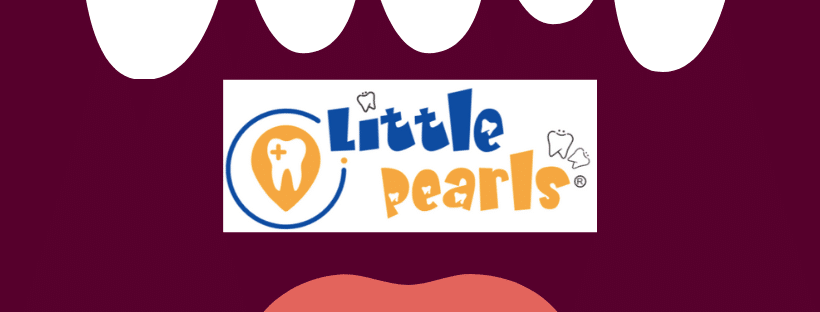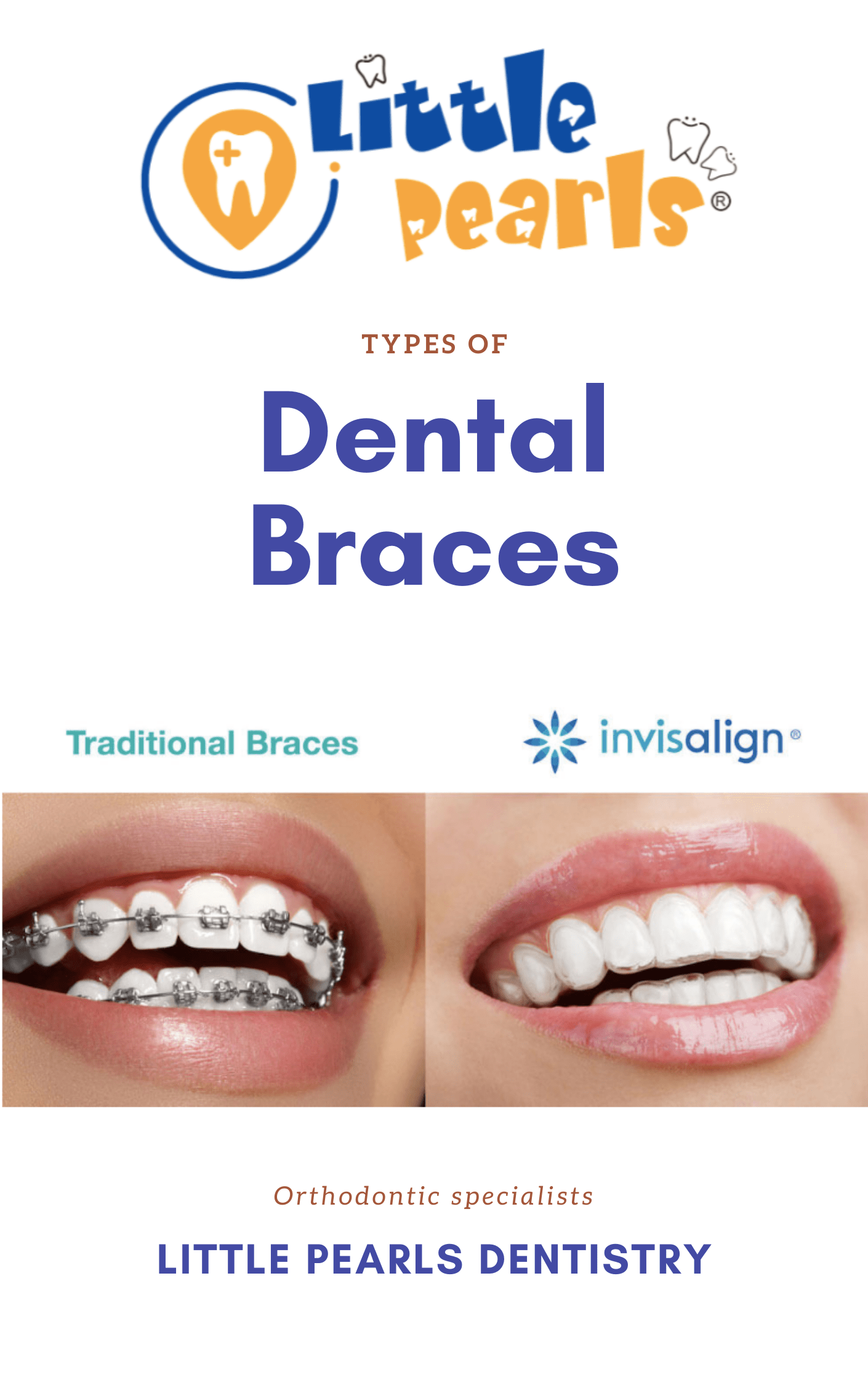TYPES OF DENTAL BRACES

By Little Pearls Orthodontics
There are many types of dental braces when it comes to Orthodontic treatment that can help in aligning your teeth and improving the functional aspects such as achieving a proper occlusion.
These include the traditional metal braces, ceramic braces, Invisalign clear aligners, and incognito braces. The above types of braces come with their own advantages & disadvantages.
“One fact that has to be considered by your doctor during orthodontic treatment planning is that the overall treatment plan should be patient-centric and customized according to your lifestyle needs as well.” – Dr. Vivek Aithal Orthodontist and Invisalign specialist
Traditional Metal Braces
These are the most commonly used and affordable types of orthodontic appliances and consist of components such as metal brackets bonded to your teeth and stainless steel wires are inserted into the slots.
Thanks to the new age technology and fabrication designs the metal brackets that are used by many Orthodontists nowadays are smaller than before. The wires inserted nowadays are mostly heat activated and use the patient’s body heat making the treatment faster and more comfortable.
Advantages of traditional metal braces – Affordable & time tested appliance.
Disadvantages of traditional metal braces – Have more visible components.
Regular Ceramic Braces
Regular Ceramic braces work very similar to the traditional metal braces. These appliances use tooth-coloured brackets and arch wires, unlike traditional metal braces which are close to silver in colour.
According to one’s lifestyle needs and requirements most people especially adult professionals opt for regular ceramic braces as they are less noticeable compared to traditional metal braces. The camouflaging colour makes many patients less conscious about the orthodontic appliance during the course of the treatment.
Advantages of ceramic braces
- They are an affordable option
- they are less noticeable compared to metal braces as they are made of a tooth-coloured material and rubber bands.
- They don’t interfere with scans such as MRI & medical imaging, unlike metal braces which interfere with the process.
Disadvantages of Ceramic braces
- The brackets are larger than metal thus oral hygiene has to be taken care of in a proper manner.
- They are slightly more expensive compared to metal braces
- In very rare cases they cause sensitive gums.
- The brackets are larger than metal thus oral hygiene has to be taken care of in a proper manner.
- .Ceramic braces from a few companies might have lesser durability compared to metal braces.
- The overall treatment duration might be slightly more compared to metal braces due to the lower friction between the wire to the bracket.
- If you consume tea and coffee regularly the chances of them getting stained will be more.
- If heavily stained the elastics & wires will have to be replaced adding a little more to the overall cost.
Self Ligating Braces
Self-ligating braces look more or less like the regular metal or ceramic braces but the movement is more advanced using a self-ligating mechanism. These are one of the most advanced types of Orthodontic braces where archwire sits in the brackets and uses an active or passive mechanism to move your teeth.
They also avoid any damage to the enamel or gums because the incremental forces delivered onto the tooth surface will be even & precise. Self-ligating braces will have lesser components compared to metal or ceramic braces. They have an archwire and no elastic bands.
The tooth movements will be more free and comfortable compared to traditional braces, thanks to the advanced mechanism of the clips and brackets. Just a small adjustment had to be made by your Orthodontist to cause precise tooth movements. This significantly reduces the number of appointments required from time to time.
Self-ligating Braces come in two types
Metal self-ligating braces & ceramic self-ligating braces which are tooth-colored.
Types of self-ligating braces:
Self-ligating braces with a passive mechanism
- The passive brackets need a smaller archwire.
- Many Orthodontists usually use the passive mechanism during the start of the treatment and then switch to active. Some also use a combination of both anteriorly & posteriorly.
- Self-ligating braces with an active mechanism
- These types of Orthodontic appliances use a comparatively larger archwire which delivers more forces causing extensive tooth movements.
- This type of mechanism causes greater tooth movements moving the tooth to the desired position at a faster pace.
Advantages of self-ligating braces
- More advanced mechanism using ligature wires
- Lesser components
- Faster and precise tooth movements
- Supplied by companies such as American Orthodontics.
Disadvantages of Self-ligating braces
They are more expensive compared to traditional braces
Lingual Braces
When it comes to traditional braces they are placed on the anterior surface of the teeth. Lingual braces are placed behind the teeth thus they can’t be seen while speaking, smiling, laughing or chewing thus they are also known as incognito braces by many.
The above features make them very compatible with the lifestyle of many individuals, especially working adults. They are very advantageous for many who are into sports or play a musical instrument as they don’t interfere with the mentioned activities.
Advantages of Lingual braces
- They are completely hidden and invisible.
- It does not interfere with the aesthetics.
- Fewer chances of lacerations on the lips & surrounding soft tissues.
Disadvantages of lingual braces
- Only an Orthodontist in Bangalore who are trained in lingual orthodontics can perform this procedure.
- Very few Orthodontic practices who follow the guidelines mentioned by the American Association of lingual orthodontics can perform the above procedure
- They are more expensive compared to regular braces
- The treatment is more complex & technique sensitive for the Orthodontist as the mechanism of tooth movements are completely different.
- The treatment duration will be more than traditional orthodontics due to its complexity.
Invisalign
Invisalign clear aligners commonly known as Invisible braces are one of the most preferred alternatives to fixed braces nowadays.
Invisalign is a state of the art orthodontic appliance developed by Align Tech which is a firm based out of California USA after many years of research and development.
It all starts with a simulation scan called the iTero element. During the Invisalign treatment process the iTero scan then simulates your entire Orthodontic treatment by using a software called ClinCheck which has data of 8 million completed Invisalign cases from around the globe. The simulation is 90% accurate & then the Orthodontist makes the required refinements which is forwarded to the Invisalign Bangalore center and then to the fabrication unit from California. Invisalign cost in Bangalore India is comparatively lower than other countries.
Advantages of Invisalign
- Precise treatment planning
- Removable, Invisible & comfortable
- Faster treatment time
- Treatment time & progress tracking is possible using the trayminder app
- The patient can access the iTero scan & treatment simulation anytime using the My iTero Link.
- You can wear these braces between 15 to 22 hours a day depending on your convenience.
- Invisalign in Bangalore is relatively cost effective compared to other places.
Disadvantages of Invisalign
- The treatment is comparatively expensive compared to traditional braces & self-ligating braces.
- Only a few orthodontists in Bangalore are certified in Invisalign.
Myofunctional Orthodontic appliances
Myofunctional Orthodontic Appliances are removable or fixed orthodontic appliances that move the teeth and jaw to guide facial growth by using the forces generated by the muscles surrounding the oral cavity & soft tissues.
The mechanism of action of myofunctional Orthodontic appliances.
These are very helpful for children & teenagers during the growth phase to guide proper facial skeletal growth & to prevent any malocclusions such as Class 2 & Class 3 when they are diagnosed by pediatric dentists. In a class 2 malocclusion, the upper jaw will be larger than the lower jaw & in a class 3 malocclusion, the lower jaw will be longer than the upper jaw. This can cause a condition called a lip trap between the lower & upper teeth in kids & teenagers.
Myofunctional Orthodontic appliances in Pediatric dentistry mostly guide the growth of the upper & lower jaws by either enhancing their overall growth or restricting them during the growth phase so that they occlude in harmony by the end of the myofunctional therapy or treatment.
When it comes to Class 3 malocclusions they can redirect the normal growth to achieve the harmonic relationship between both the dental arches. Myofunctional appliance therapy at an early age can go a long way in preventing serious maloccusions during Orthodontic care at Little Pearls which will be difficult to correct at a later stage in kids & teenagers.
A few examples of myofunctional appliances include:
Removable myofunctional appliances: The activator, frankles appliance 1 & 2, The twin block appliance and many more.
Fixed myofunctional appliances – The Jasper jumper & the Herbst appliance.
Many kids inherit malocclusions as there will be a difference in the size of the lower & upper jaw when each of them is inherited from a different parent. So if the parents had undergone treatment with braces to correct this problem is more likely that the kids will need Orthodontic treatment too.
Early childhood braces go a long way in correcting many malocclusions such as crooked teeth, anterior proclination in Kids when it comes to pediatric orthodontics. These are easier to correct at an early age compared to the adult phase. Kids can also opt for their favorite color bands according to their preferences.
An underbite is seen in children when the size of the lower law is larger compared to the size of the upper jaw. Overbites are caused in kids when the size of the upper jaw is larger when compared to the size of the lower jaw.
A malocclusion such as overcrowding and crooked teeth can be caused in kids when they lose the milk tooth/teeth due to early exfoliation, trauma or accidents. The dental braces cost in Bangalore for kids usually starts at 9000 INR for myofunctional appliances and 25000 INR for traditional metal braces making them very affordable for many parents! The space of the lost area should be maintained by using an appliance called the space maintainer gave by pediatric dentists who specialise in the field of Pedodontics.
Pediatric dentists can easily diagnose the malocclusion during their routine dental checkup and will coordinate with the Orthodontist to start the pediatric or preventive orthodontic treatment planning if necessary. The Orthodontist will later determine the orthodontic appliance and the duration of the treatment for your child after your kids first visit to the pediatric dentist.
Teenagers will be benefitted at an early age as the tooth movements will be easier to conduct by the orthodontist at this age. The American Academy of Orthodontics recommends getting an orthodontic consultation for your child once the permanent teeth start erupting. Pediatric Orthodontics doesn’t essentially mean that the child has to get braces immediately. It is more of a preventive approach.
LITTLE PEARLS ® Dental Clinic Bangalore
Address: BTM 2nd Stage – No 46 , 1st Floor, 1st Main Road, 7th Cross Rd, BTM Layout, Bengaluru, Karnataka 560076











